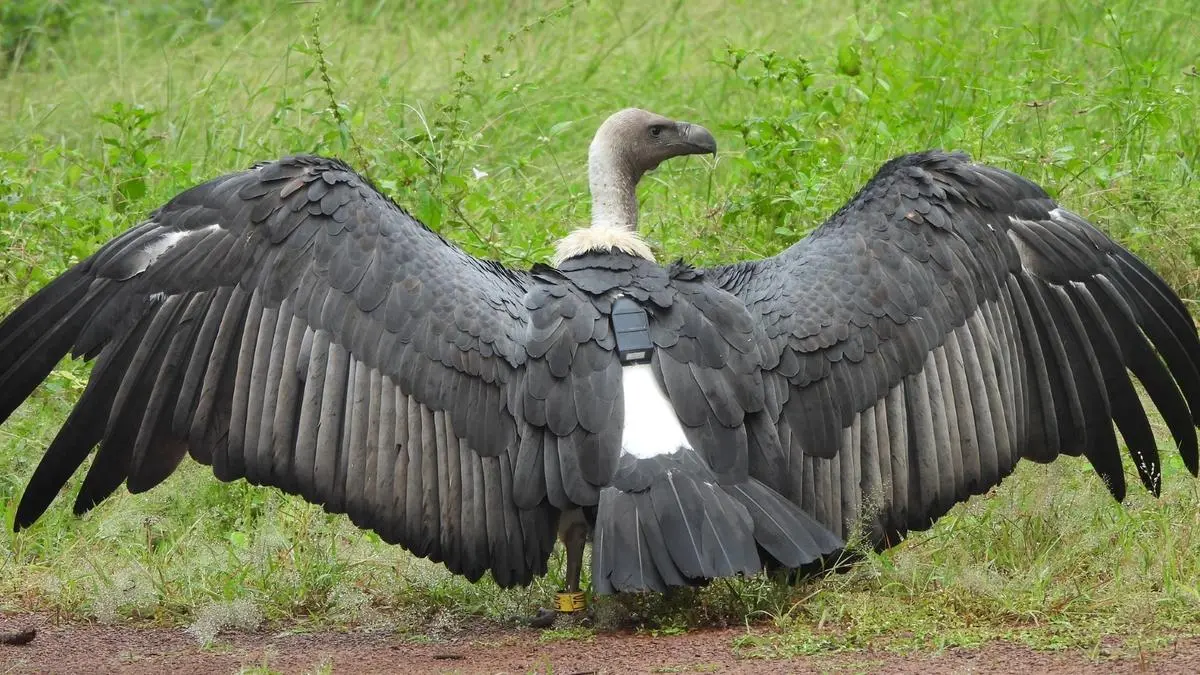On January 16, 2021, a large, blotchy, elliptical egg began to crack open at the Vulture Conservation and Breeding Centre (VCBC) in Pinjore, Haryana. The captive-bred chick pushed through her calcite cocoon, in which she had laid curled up cosily for two months. When she emerged, she was covered in soft grey down and was still blind.
Over the next few months, the fluffy, wide-eyed chick would grow, and grow some more, into a large, not-so-gainly creature. “N11”, as this particular white-rumped vulture was named, now had a gleaming hooked bill, a distinct hunch, an almost featherless head, a mighty wingspan, and piercing eyes. Now, this countenance is a complete antithesis to its benign nature: this taloned bird does not hunt its prey, it scavenges on carrion.

The white-rumped vulture happens to be one of India’s most critically endangered species. From 40 million individuals in the 1980s, three vulture species in India (the white-rumped vulture, the long-billed vulture, and the slender-billed vulture) suddenly faced near-extinction in 2007. The white-rumped vulture fared the worst: its numbers had whittled down catastrophically to just 0.
1 per cent of its original population. The decline of vultures in India was the fastest among any bird species in the world’s recorded history, and the largest in magnitude since the extinction of the passenger pigeon in the US, according to a new research paper published in 2024 in the The American Economic Review ( AER ) journal by the scientists Eyal Frank and Anant Sudarshan. Also Read | Human-wildlife conflict can reduce only if community rights are recognised: C.
R. Bijoy Soon, a singular cause of their decimation was deduced: diclofenac, a painkiller that humans still use and which dairy farmers had started to inject their ailing cattle with in 1994. And when these cattle eventually became carrion, they were scavenged upon by vultures that ingested the diclofenac-infused meat.
The drug proved toxic to vultures. Their kidneys failed, and within weeks, they were dead. And in their millions.
In 2006, the Central government banned diclofenac for veterinary use. Earlier, in 2001, the Bombay Natural History Society (BNHS) and the Haryana Forest Department established the VCBC to captive-breed and release the birds into the wild. N11 was a product of the VCBC’s critical initiative.
Last August, while still a sub-adult, she was fitted with a global system for mobile communications tag and released into the wild in Maharashtra’s Tadoba-Andhari Tiger Reserve, along with nine other white-rumped vultures. One of the biggest conservation stories from India is the growth in its elephant population, which now stands around 27,000. In the picture, elephants at the Corbett National Park.
| Photo Credit: ISTOCK/GETTY IMAGES The urgency to save this species is not just about conserving biodiversity: it is about saving human lives too. The collapse of vultures in India led to the death of no fewer than 1,04,386 people between 2000 and 2005 from the sheer “shock to sanitation”, according to The AER paper. The importance of wildlife Without the sanitation services provided by vultures (a group can reduce the carrion of an entire cow to bones within 40 minutes), carcasses were left to rot, lowering the dissolved oxygen in water and releasing faecal coliform into the environment.
“Rotting carcasses can also transmit pathogens and diseases, such as anthrax, to other scavengers,” the authors said in the paper. The dead cattle also began to attract dogs and rats, exposing humans to zoonotic diseases such as rabies. Indeed, the researchers observed a “sharp increase” in the sale of rabies vaccines after 1996.
The story of vulture N11 holds a critical lesson for India: the inextricable link between wild species, human well-being, and livelihoods. The country is home to nearly 8 per cent of the world’s documented species, with 92,037 animal species—including insects—and 45,500 plant species, according to the 2024 Global Nature Conservation Index. Human health and biodiversity loss In the midst of the sixth mass extinction in the history of the planet, there is an evolving discourse on biodiversity loss in the context of human health and economics.
For instance, recent research shows how the decline of insectivorous bats in some parts of the world has impacted biological pest control, forcing farmers to invest more in insecticides. Similarly, a 2021 paper published in Proceedings of the National Academy of Sciences talked about how restoring wolf populations can reduce deer-vehicle collisions in Wisconsin, US. It said that about 1 million such collisions occur every year in the entire US, “causing 29,000 human injuries, 200 human fatalities, and nearly $10 billion in total economic losses”.
A 2022 study in Environmental Research Letters showed that an amphibian collapse from a fungal pathogen brought in via the international pet trade in Costa Rica and Panama increased the incidence of malaria in people. Here, the authors discuss the link between biodiversity loss and “the often-hidden human welfare costs of conservation failures”. The WHO references recent studies that estimate that more than 75 per cent of emerging infectious diseases are zoonotic—think COVID-19.
These diseases, which jump from animals to humans, often arise in areas where ecosystems and habitats have been disrupted by deforestation or land-use change. The case of Kyasanur forest disease This is exemplified in our Western Ghats, where a tick-borne viral disease, the Kyasanur forest disease (KFD), has raged since the 1950s as forests got rapidly fragmented and cleared for mining, building roads, and agriculture. “Monkey fever”, as this zoonotic disease is referred to, was first discovered in the Kyasanur forest range in Karnataka’s Shivamogga district.
Over the next few decades, the disease spread to Kerala, Tamil Nadu, Maharashtra, and Goa. The tick’s hosts include shrews, langurs, and birds, from which it jumps to cattle and humans—largely marginalised, forest-dependent communities. Around 500 people are infected every year; the mortality rate from this haemorrhagic disease is between 10 per cent and 15 per cent.
Between 2012 and 2017, there were at least 340 human deaths, and the numbers are not showing signs of abating. In 2024, Karnataka reported 14 deaths and 303 confirmed cases of KFD. On March 17, Karnataka reported its first death from KFD this year, with 95 positive cases reported so far.
Prashanth N. Srinivas, a researcher at the Institute of Public Health in Bengaluru, said that the disease is best addressed through the concept of “One Health”, which “recognises that the health of humans, domestic and wild animals, plants, and the wider environment (including ecosystems) are closely linked and interdependent”, as the WHO defines it. According to Srinivas, the only way we can tap into “the full potential” of One Health is when State governments create a One Health policy “that is in line with the recommendations of the National One Health Mission”.
Such a policy could ensure the coming together of several departments and stakeholders from fields ranging from agriculture, health, and veterinary science, to education, he told Frontline . Age of zoonotic diseases In this age of zoonotic diseases, when wild species are viewed with fear, how do we begin to understand the irreplaceable role they play in our lives and in our shared environment? Speaking to Frontline , Eyal Frank, lead author of The AER paper, said: “Since COVID-19, people have been concerned about bats and their ability to be a host to many different viruses. Zoonotic disease outbreak often occurs because humans encroach on the habitats of those wild animals, which is part of the drivers that are reducing biodiversity.
” He added: “The elevated risk of zoonotic disease outbreak is part of the negative impact of degrading habitats. Even if bats present a kind of risk to us, they are also important in providing many benefits, such as biological pest control (in the case of insect-eating bats) or pollination (in the case of fruit-eating bats).” India, meanwhile, has been ranked an abysmal 176 out of 180 nations listed in the 2024 Global Nature Conservation Index (NCI), and clearly has a huge task ahead of it: to undo the damage that has been done to species and their ecosystems and to preserve what remains.
For instance, no less than 23,300 square kilometres of tree cover was lost between 2001 and 2019, according to the NCI report, which added that 15.9 per cent of marine species and 13.4 per cent of terrestrial species are at risk.
On March 25 this year, Bhupender Yadav, Union Minister for Environment, Forest and Climate Change, told the Lok Sabha that between 2014-15 and 2023-24 an astonishing 1.7 lakh ha of forest land had been approved for non-forestry purposes, including infrastructure projects. “Critically endangered” species in India Indeed, India’s “critically endangered” wild species on the Red List of the International Union for Conservation of Nature (IUCN) include every animal group and also plants: the nearly extinct great Indian bustard; the herbaceous Indian nard that has been over-harvested for medicinal use; gharial, the fish-eating crocodile; the “Kashmir stag” or hangul that is threatened by poaching and armed activity; the Indian swellshark often killed by shrimp trawlers; and the iridescent peacock tarantula that is prized in the international pet trade.
And it is not just wild species that are dying out: entire ecosystems are. Open habitats such as grasslands, semi-arid landscapes, and deserts and also croplands, grazing lands, and fallow land have suffered a history of neglect. They are often converted into plantations or “forests”, according to the State of India’s Birds report, 2023, which aggregates data uploaded by birdwatchers on the eBird site.
For instance, less than 1 per cent of the country’s grasslands is protected, the report said, adding: “Birds that live in open habitats have declined tremendously.” These include the great grey shrike, which has declined by a staggering 80 per cent over 25 years; the critically endangered great Indian bustard; and the lesser florican, the smallest bird in the bustard family. It is the very “openness” of these habitats that makes them vulnerable to “the spread of invasive, drought-tolerant woody plants, as well as wind turbines and power lines”, said the report, which is based on citizen science and produced through the partnership of 14 organisations, including the BNHS, the Ashoka Trust for Research in Ecology and the Environment, and the Wildlife Institute of India.
The lesser florican It points specifically to the lesser florican, which “has been declining more precipitously” than the great Indian bustard “but has not received the same conservation attention”. Also Read | Editor’s Note: A sanctuary for the few, a graveyard for the many Distinctive for the long, ribbon-like feathers that flutter on either side of its head, the male of the species is known for its peculiar breeding display: the little bird leaps up vertically, several feet high, flapping its wings rapidly as it calls. Now believed to number fewer than 1,000, down from over 3,500 some 20 years ago, this bird unsurprisingly went from being classified as “threatened” in 1988 to “critically endangered” in 2021 in the IUCN Red List.
Meanwhile, the NCI report that placed India at almost the very end of its list of countries on conservation, made it to the Rajya Sabha in November 2024, and a predictably defensive response from Kirti Vardhan Singh, Union Minister of State for Environment, Forest and Climate Change, followed. The lesser florican, the smallest bird in the bustard family and an inhabitant of India’s grasslands, has been declining more precipitously than the great Indian bustard, but has not received the same conservation attention. | Photo Credit: ISTOCK/GETTY IMAGES The NCI ranking “undermin[ed] the well-recognised efforts of India in land management, threats to biodiversity, capacity and governance and climate change mitigation”, he said, adding that the index “has not taken into account the country reported data [on] indicators and relied on many other sources leading to [an] unrealistic NCI index”.
Major success stories in conservation There have, however, been some major success stories, at least in the conservation of large “charismatic” mammals. Tigers, which numbered 1,800 in the early 1970s and were predicted to go extinct in the country by the end of the 20th century, are now thriving with a population of more than 3,600 today, thanks to initiatives such as Project Tiger, said the ecologist Raman Sukumar, honorary professor and national science chair, Centre for Ecological Sciences, Indian Institute of Science, Bengaluru. The Asiatic lion, which numbered just 177 in the 1970s, and was largely confined to the Gir National Park in Gujarat, is 674-strong today.
Speaking to Frontline , Sukumar said: “The one-horned rhinoceros, believed to have numbered about 600 in the 1960s, was found only in Kaziranga in Assam and a few other places such as Jaldapara in West Bengal. Today, the rhino population is over 2,600 in Kaziranga alone, apart from significant increases in other places.” Similarly, the elephant population, which numbered between 12,000 and 15,000 in the 1970s, has grown to 27,000 today, aided by initiatives such as Project Elephant.
However, Sukumar pointed out that as these populations increase, a fresh management challenge has been created: conflicts between wildlife and people. He said: “Wild animals increasingly destroy agricultural crops, prey on livestock, damage houses—and kill people. The march of development that fragments or reduces natural habitats only adds to this conflict.
We need a new policy framework, with clear population targets, and scientific management to minimise conflicts.” He also said that a closer involvement of local communities and traditional knowledge systems must be incorporated into these conservation schemes. According to him, it is also time that our conservation efforts shifted from these flagship species “to less-studied creatures, which are equally critical to the country’s wildlife diversity”.
How N11’s story ended The white-rumped vulture N11, released into the wild last August, would be one such creature. But her story, sadly, did not end well. The bird, first tentative in her new environment, hovered around Tadoba for the first three days after release.
She then took off: first on a 300 km journey to Raipur, Chhattisgarh, only to turn back to Maharashtra, and then north to Madhya Pradesh, west to Gujarat, and south to Karnataka and Tamil Nadu. So, in five months, this bird travelled nearly 4,000 km, across six States. Cheetahs at the Kuno National Park in Madhya Pradesh.
Since the reintroduction of these African big cats in India in 2022, more than 10 animals have died. | Photo Credit: PTI On January 16 this year, exactly to the day she hatched four years ago, the bird collided with a power line in Pudukottai, Tamil Nadu, and died from electrocution. Things are not looking good for the other captive-bred vultures released either.
Of the 10 white-rumped vultures released in Tadoba, only 2 survive today; the rest succumbed to electrocution or just went missing, said Bhaskar Das, a biologist with the BNHS. “Rewilding” and its limits But there have also been remarkable examples of “rewilding” in India, such as the conservation and reintroduction of the critically endangered pygmy hog, the world’s smallest pig, in Assam, said T.R.
Shankar Raman, a wildlife scientist with the Nature Conservation Foundation. Thought to have gone extinct in the 1970s, as many as 170 hogs have been captive bred and reintroduced in Assam’s protected areas since 2008 as part of the Pygmy Hog Conservation Programme. Also Read | Indian grey wolf: Persecuted guardian of the grasslands He said: “Ecological restoration is both a hopeful premise and a scientific approach to regain original biodiversity and the ecological functioning of a habitat.
” There are several ways to achieve it. “Planting native trees in damaged forests (reforestation), reviving grasslands, removing invasive species or monoculture plantations and rewilding an area by reintroducing lost animal species,” he said. However, quick-fix “solutions”—such as creating Miyawaki thickets, seed bombing, or random regreening—“are not restoration”, he added.
Projects such as the ongoing cheetah introduction programme are also concerning as “they appear to be directed at a few charismatic, large mammals, while ignoring several other species and also the protection and revival of original ecosystems such as grasslands”, Raman told Frontline . Ultimately, Raman warned, it is important to remember that we cannot destroy an ecosystem in the belief that “it can somehow be restored. Neither restoration nor rewilding can ever recover everything we have lost.
” CONTRIBUTE YOUR COMMENTS SHARE THIS STORY Copy link Email Facebook Twitter Telegram LinkedIn WhatsApp Reddit.
Environment

The sixth mass extinction is here—and it’s killing humans too
India’s vanishing wildlife is no longer just a biodiversity crisis—it is a public health emergency born of human-induced ecological collapse.















